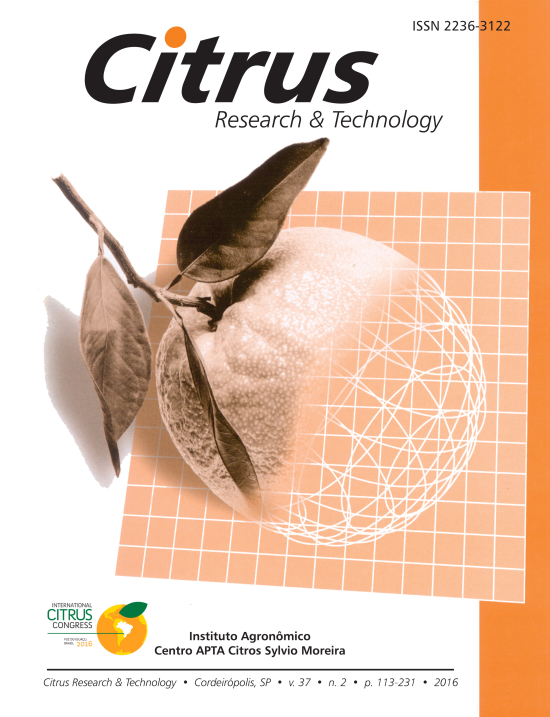Variabilidade genética em genótipos da coleção de germoplasma de Citrus, do Instituto Agronômico de Pernambuco Brejão-PE, por meio de marcadores moleculares ISSR
Genetic variability in genotypes of the germplasm collection of citrus from the Instituto Agronômico of Pernambuco Brejão-PE, by using ISSR molecular markers
Rômulo Maciel Moraes Filho, Horace José Jimenez, Angélica Virgínia Valois Montarroyos, Rosimar dos Santos Musser, Mairon Moura da Silva, Edson Ferreira Silva & Luíza Suely Semen Martins
Resumo
O Brasil é o maior produtor de laranja respondendo por 50% da produção mundial, tendo no ano de 2009 produzido mais de 18 milhões de toneladas, em uma área plantada de 990 mil hectares. Apesar dos recentes avanços da citricultura nacional, existe pouca diversificação, sendo as variedades de laranjas Pêra, Natal, Valência e Hamlin as de maior representação nacional. Na região Nordeste, onde a situação é ainda mais grave, a laranja Pêra é responsável pela grande maioria da produção. O município de Garanhuns/PE e os municípios vizinhos do Agreste Meridional apresentam potencial de expansão para o cultivo de variedades de citros para o consumo in natura devido, principalmente, à altitude. O objetivo deste trabalho foi atestar a variabilidade genética, por meio de marcadores moleculares ISSR, das variedades do gênero Citrus a serem introduzidas e recomendadas para a região Nordeste pela Embrapa Mandioca e Fruticultura. A metodologia ISSR-PCR permitiu a visualização de um total de 167 locos com a utilização de 15 primers. Destes 162 locos (97%) exibiram polimorfismo e cinco (3%) foram monomórficos. De acordo com a análise do dendrograma e da matriz de similaridade genética foi possível agrupar as 15 variedades de laranja doce em um único grupo com 27% de diversidade entre si e 40% em relação aos outros cinco genótipos, formados por três limões, uma tangerina e um pomelo. O alto grau de polimorfismo observado sugere uma grande variabilidade genética entre as 15 variedades estudadas, o que é desejável para a diversificação de variedades a serem indicadas futuramente para o Agreste Meridional de Pernambuco.
Palavras-chave
Abstract
Brazil is the largest orange producer and accounts for 50% of the world production. In 2009 Brazil produced over 18 million tons, in a planted area of 990,000 hectares. Despite recent advances in the national citrus industry, there is little diversification of cultivars and varieties, which include basically Pera, Natal, Valencia and Hamlin. In the Northeast, the predominance of Pera varieties is even more intense and represents most of the production. Garanhuns/PE and its neighbor cities (Agreste Meridional) show potential for citrus production expansion, mainly due to the altitude. The objective of this work was to access the genetic variability among citrus plants that were introduced and recommended to the Northeast region by Embrapa Mandioca e Fruticultura, by using by ISSR markers. The ISSR-PCR method allowed the visualization of 167 loci with the use of 15 primers. A hundred sixty-two (97%) loci exhibited polymorphism and five (3%) were monomorphic. According to the analysis of the dendrogram and the genetic similarity matrix, it was possible to group the 15 varieties of sweet orange in a single group with 27% diversity among them and 40% over the five other genotypes, consisting of three lemons, a tangerine and a grapefruit. The high degree of polymorphism observed between the group of oranges and the other five accessions suggests a large genetic variability within the genus, which may be particularly useful in breeding programs aiming to develop new rootstocks adapted to many different environmental conditions as well as the identification of promising varieties in terms of production.

